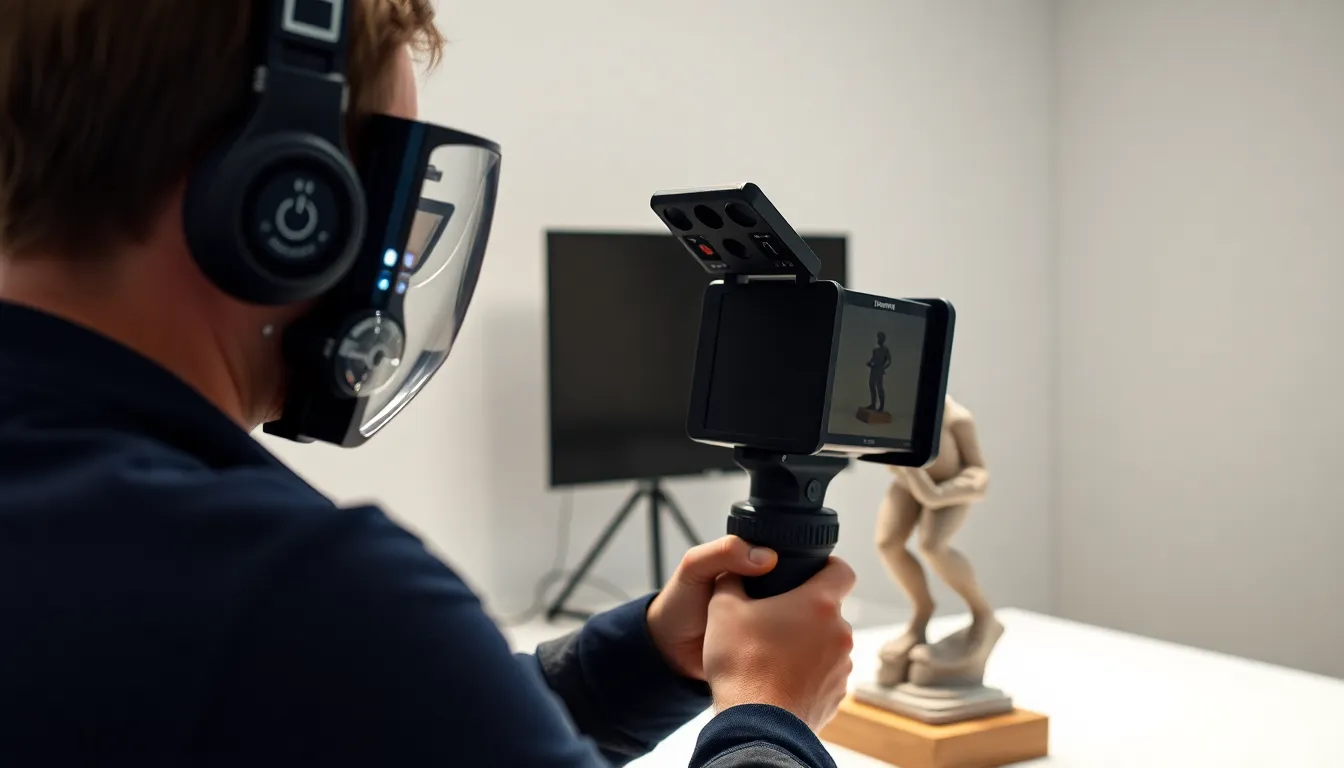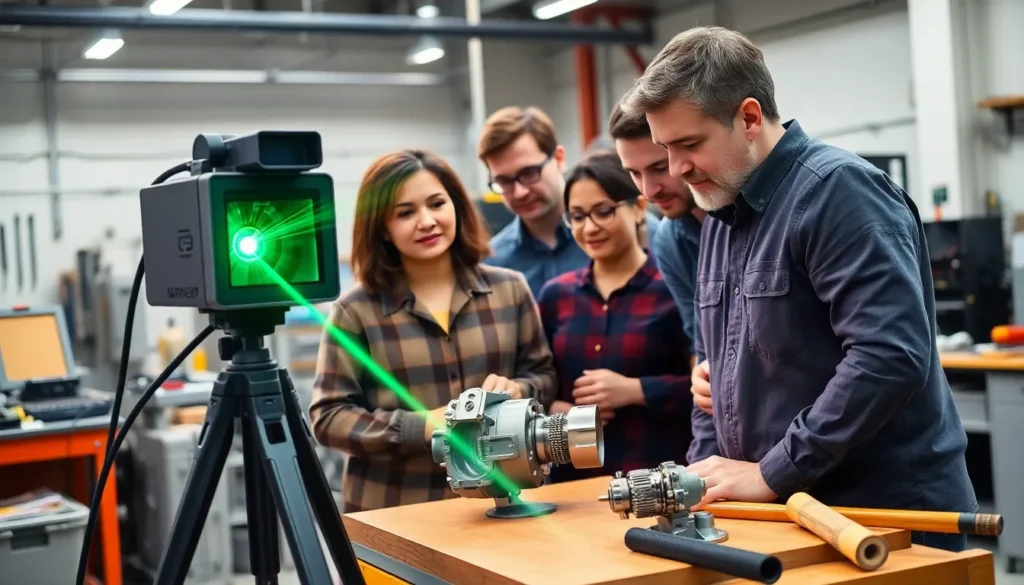In today’s fast-paced technological landscape, 3D scanning equipment has emerged as a game-changer across various industries. From manufacturing to healthcare, this innovative technology captures precise measurements and intricate details, transforming the way professionals approach design and production. With the ability to create digital replicas of physical objects, 3D scanners streamline workflows and enhance accuracy.
As businesses strive for efficiency and quality, understanding the different types of 3D scanning equipment available is crucial. Each device offers unique features tailored to specific applications, making it essential for users to choose wisely. This article delves into the key aspects of 3D scanning technology, highlighting its benefits and guiding readers in selecting the right equipment for their needs.
Table of Contents
ToggleOverview of 3D Scanning Equipment
3D scanning equipment captures real-world objects’ shapes and dimensions, converting them into digital models. Various methods exist, including laser scanning, structured light scanning, and contact scanning. Each method caters to different industry needs, offering unique advantages.
Types of 3D Scanners
- Laser Scanners: Capture precise measurements using laser beams. They excel in large-scale applications, such as architecture and civil engineering.
- Structured Light Scanners: Use projected light patterns to capture data. Ideal for small to medium-sized objects, they deliver high-resolution scans in automotive and consumer product design.
- Contact Scanners: Rely on physical contact with the object to gather data. These scanners provide high accuracy, commonly used in quality assurance and inspection processes.
Key Features to Consider
- Accuracy: Essential for precision-dependent applications. Equipment must provide documented accuracy specifications.
- Speed: Determines how quickly scans can be completed. Fast scanning benefits industries with tight deadlines, such as manufacturing.
- Portability: Aids in capturing data in remote locations. Portable devices suit on-site inspections in various fields, including archaeology and construction.
Applications of 3D Scanning Equipment
- Manufacturing: Improves product design and quality control, enabling rapid prototyping and efficient assembly processes.
- Healthcare: Facilitates the creation of personalized medical devices using patient-specific scans, enhancing surgical planning.
- Cultural Heritage: Assists in the preservation of artifacts by creating detailed digital records, providing access for research and education.
Selecting the right 3D scanning equipment depends on specific project requirements, including object size, desired level of detail, and application context.
Types of 3D Scanning Equipment

Understanding the various types of 3D scanning equipment assists in selecting the appropriate tools for specific applications. This section explores three primary types: laser scanners, structured light scanners, and handheld scanners.
Laser Scanners
Laser scanners capture high-resolution 3D data using laser beams to measure distances to the target object. These devices excel in creating detailed point clouds, suitable for large environments or complex geometries. Key features include:
- High accuracy: Laser scanners achieve precision up to 0.1 mm, ideal for engineering and construction applications.
- Speed: Some laser scanners can collect millions of points per second, enhancing workflow efficiency.
- Range: They typically operate over substantial distances, with capabilities exceeding 300 meters, making them suitable for outdoor scanning.
Structured Light Scanners
Structured light scanners employ projected light patterns to capture 3D information. They are particularly effective for smaller objects or detailed features. Notable characteristics include:
- High-resolution detail: Structured light scanners capture fine surface details, beneficial in industries like jewelry or art restoration.
- Speed: These scanners perform rapid scans, often completing a measurement within seconds.
- Versatility: Suitable for various materials, they adapt well to both reflective and matte surfaces.
Handheld Scanners
- Lightweight design: Many handheld scanners weigh less than five pounds, supporting ease of use during extended periods.
- User-friendly: Simple interfaces and real-time feedback make them accessible for non-experts.
- Adaptability: These scanners often support multiple scanning modes, accommodating diverse project requirements.
Applications of 3D Scanning Equipment
3D scanning equipment serves a variety of industries, enhancing processes and outcomes through accurate data capture. Significant applications include manufacturing, architecture, and healthcare.
Manufacturing and Prototyping
3D scanning equipment contributes to manufacturing and prototyping by enabling rapid design iterations and precise quality control. Laser scanners capture geometric data from existing components, allowing designers to create accurate 3D models. Structured light scanners expedite the prototyping phase, providing high-resolution scans of prototypes for evaluation. Handheld scanners facilitate easy scanning in tight spaces, ensuring that smaller parts fit seamlessly into larger assemblies. These capabilities improve production efficiency and reduce costs associated with design revisions.
Architecture and Construction
In architecture and construction, 3D scanning equipment aids in surveying and documenting existing structures. Laser scanners generate detailed point clouds, creating accurate site models for analysis and design modifications. Structured light scanners allow architects to assess intricate details of historical buildings, ensuring preservation during renovations. Portable handheld scanners provide architects with the flexibility to collect data on-site, streamlining communication with construction teams. These applications promote collaboration among stakeholders and enhance overall project outcomes.
Healthcare and Medical Imaging
3D scanning equipment plays a crucial role in healthcare by enabling tailored medical solutions. Laser scanners and structured light scanners create precise anatomical models for surgical planning and training. These models assist surgeons in visualizing complex operations, improving outcomes for patients. Additionally, handheld scanners facilitate the design of custom prosthetics and implants, enhancing comfort and functionality for users. By providing personalized solutions, 3D scanning transforms patient care and medical research significantly.
Benefits of Using 3D Scanning Equipment
3D scanning equipment offers several advantages across various industries, enhancing efficiency and precision.
- Enhanced Accuracy: 3D scanning equipment captures precise measurements, minimizing human error. High-end laser scanners achieve accuracy levels of up to 0.1 mm, critical for applications requiring detailed specifications.
- Increased Speed: 3D scanning drastically reduces the time needed for data collection. For instance, laser scanners can collect millions of data points per second, expediting project timelines significantly.
- Cost Savings: 3D scanning reduces costs by improving design processes and minimizing waste. Faster iterations allow for timely corrections and adjustments, ultimately leading to lower production expenses.
- Improved Design Quality: 3D scanning enables designers to visualize complex objects accurately. High-resolution scans facilitate better decision-making in design and prototyping, enhancing the overall quality of products.
- Versatile Applications: 3D scanning equipment suits various fields, including engineering, healthcare, and cultural preservation. Its adaptability allows professionals to use it for tasks like creating anatomical models, archiving historical artifacts, and surveying construction sites.
- Enhanced Collaboration: 3D scanning promotes better communication among stakeholders. Detailed scans provide a common reference point for teams, improving coordination during projects.
- Portability and Ease of Use: Handheld scanners offer lightweight solutions for mobility and ease of use, enabling operators to scan locations without bulky equipment. Their design fosters a user-friendly experience across diverse environments.
Challenges in 3D Scanning
3D scanning technology faces several challenges that can impact its effectiveness and usability. Understanding these challenges is crucial for industries looking to implement 3D scanning solutions.
- Cost of Equipment: High-quality 3D scanners often come with substantial price tags. Organizations may face budget constraints that limit access to advanced scanning technologies, affecting project outcomes.
- Complexity of Software: Many 3D scanning systems require intricate software for processing and modeling data. Users often encounter steep learning curves, which can lead to delays and inefficiencies during implementation.
- Environmental Interference: External factors, such as lighting conditions, surface texture, and ambient temperature, can hinder scanning accuracy. Adapting to diverse environments remains a significant challenge for users.
- Data Processing Requirements: Processing the large amounts of data generated by 3D scans requires robust computing power. Inadequate hardware can result in slow processing times, delaying project delivery.
- Accuracy and Precision Issues: While many scanners boast high accuracy rates, external conditions and material characteristics can affect results. Users must account for these variables to ensure reliable data collection.
- Limited Range and Scale: Some scanners are designed for specific sizes or types of objects, limiting their versatility. The need for multiple types of scanners to handle different tasks increases complexity and costs.
- Fragmentation in Standards: The lack of standardization across 3D scanning technologies can lead to compatibility issues. Different file formats and protocols inhibit seamless data sharing among platforms.
Addressing these challenges requires careful consideration and planning to maximize the benefits of 3D scanning technology within various applications.
3D scanning equipment is revolutionizing how industries approach design and production. Its ability to capture precise measurements enhances accuracy and efficiency while minimizing human error. By understanding the various types of scanners available and their unique features, businesses can select the right tools for their specific needs.
Despite challenges like high costs and software complexity, the benefits of 3D scanning far outweigh these hurdles. As technology continues to evolve, the applications of 3D scanning will likely expand further, making it an invaluable asset across multiple sectors. Embracing this technology can lead to significant improvements in productivity and collaboration, paving the way for innovative solutions in the future.




